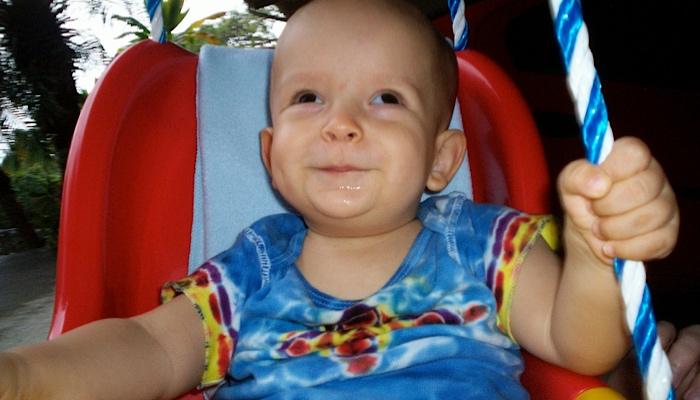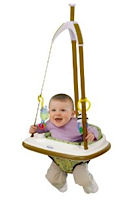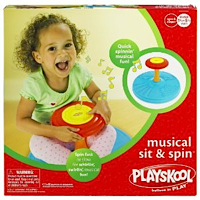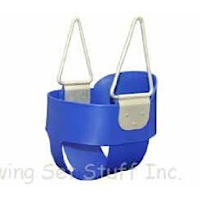Vestibular Stimulation: Making Sense of the Other Senses When Your Child is Blind

This post may contain affiliate links; please see our terms of use for details.
By Jennifer Stevens
We all experience the world through our senses: vision, hearing, etc. But have you heard of propriopception or vestibular sense?
Our proprioceptive sense tells us what our body is doing in relation to itself (Is my hand in front of me or behind? How can I get my hand to my mouth?)
Our vestibular sense tells our body where we are in space (Am I standing up or laying down? Am I leaning to the right or standing up straight?)
All of our senses work together to give us information about our bodies and our environment. But when something isn’t working right (whether through vision or hearing loss or neurological disorders) the entire system can malfunction.
This can explain why children with vision impairments might want to sit and rock, which is often referred to as a “self stimulation”. They may be trying to fill in some of that vestibular information their brain is missing out on.
Jennifer writes about her experience with her son, Gavin, and the ways they’ve tried to help him direct this energy into physical activities that are both fun and add vestibular stimulation. She begins with a line that could be read as a poem…
We are flying by the seat of our pants with what we know;
Everything we learn, is as we go.
We find a problem, do some research, network with other parents of blind children, and figure out what to do. One big challenge everyday is providing enough vestibular stimulation for Gavin. I will share with you how we handle it, and hope you can help by sharing what you do as well.
-
- Row Row Row Your Boat: Gavin LOVES this song, and we sing it about fifty times a day (no joke). He sings it to himself too, and it is my cue he is needing some vestibular stimulation. We typically do it with my holding his hands and him standing. I’ve also tried doing it with him in a sitting position, to also give him a different sense of movement.We “row” back and forth throughout the duration of the song, and then it’s a game when he starts jumping up and down mid song and I sing the words faster. When the song is over he jumps to the floor and claps and says “YAY!”. It’s a big production, and then we start again. This is something we do all the time, not just at home and it has saved us when we are out shopping, at a wedding, or in an unfamiliar area for him. Best part, it’s free!
-
 Jumper: We thought Gavin was over his Jumper months ago, until daddy tried moving it to the garage. He heard the music and went nutso! He now uses it every other day, and it is still great for him, even at 17 months. He jumps up and down (with great force) and laughs while doing so. We will keep using it until he is done with it, or outgrows it. Until then, jump away!
Jumper: We thought Gavin was over his Jumper months ago, until daddy tried moving it to the garage. He heard the music and went nutso! He now uses it every other day, and it is still great for him, even at 17 months. He jumps up and down (with great force) and laughs while doing so. We will keep using it until he is done with it, or outgrows it. Until then, jump away!
-
- Side to Side: This is something I made up with Gavin, while just playing on the ground one day. He stands up, holds my hand and we sing the side to side song. All I do is say “Siiiiide to Siiiiide”, trying to carry a tune mind you. (I’m glad he doesn’t care that mommy has a horrible voice). When I say “side to side”, he moves side to side. Then I say, “Up, down” and he jumps up and down, then it’s on to “back and forth” and he moves back and forth. We do it fast and slow, and I mix it up and he LOVES it. It’s a game, but he is getting used to direction and where he is within his space.
-
 Sit ‘n Spin: We bought a Sit ‘n Spin for Gavin months ago, but he was still too small. Now that he’s bigger, it’s great for him to spin around on and provides fun times for him and his brother to play together.
Sit ‘n Spin: We bought a Sit ‘n Spin for Gavin months ago, but he was still too small. Now that he’s bigger, it’s great for him to spin around on and provides fun times for him and his brother to play together.
-
- Ding Dong: This sounds funny, but my Grandpa would do this to us grandkids when we were small. We have carried on the tradition and have been doing it with both kids since they were very small. We have Gavin on his back on the floor, we tell him to give us his feet and his hands. With your left hand, you hold his right hand and his right foot (at the ankle). With your right hand, you get his left hand/left foot (ankle). You pick him up off the floor, and you swing him up and down between your legs, The song goes like this, “Ding dong, ding dong, one, two, three!”.At three you release the feet. We haven’t done this yet with Gavin, we will wait until he is older to release his feet. We just gently put him back on the floor after “three”, until he stops requesting “MORE”. Which is usually after the 20th time! We build up the anticipation with the counting, and put a lot of emphasis on the count. Both boys LOVE this, and we are usually pretty beat after it’s over! Also FREE!
-
 Bucket swing: We installed a Bucket Swing in our garage. We are usually outside everyday when Landon, Gavin’s brother, gets home from school, or right before dinner. Landon rides his bike or scooter and Gavin swings. The bucket swing is great. It’s cheap and all we needed to buy were two eye hooks from Home Depot to install. He gets to be outside in the fresh air and puts his hands up when he swings (which is great to keep them out of his eyes).
Bucket swing: We installed a Bucket Swing in our garage. We are usually outside everyday when Landon, Gavin’s brother, gets home from school, or right before dinner. Landon rides his bike or scooter and Gavin swings. The bucket swing is great. It’s cheap and all we needed to buy were two eye hooks from Home Depot to install. He gets to be outside in the fresh air and puts his hands up when he swings (which is great to keep them out of his eyes).
-
- Windows Down: This is a LIFESAVER when we are driving. Imagine how boring it is for little ones to sit strapped in their car seat, and for a blind baby, not able to have the option to look out the window. Even if we put his favorite music on, automatically this is a huge opportunity for eye-pressing. But he does LOVE to have the back windows down and feel the wind against his face/hair and he puts his hands up to feel the wind go through his little fingers. When I tell him we are getting ready to “go”, I make it a big production and say “we’re going to put the windows down!” He instantly laughs and puts his hands up. He can’t wait for car rides!
- Airplane: This is usually something daddy does with him. Gavin is getting bigger, and I’m afraid I’m going to drop him. This is your usual, pick him up under the tummy, ask him to spread out his arms and legs and you act like an airplane. We’ve added some big up and down and swooping movements for him for additional vestibular stimulation. They go flying all through the house, just make sure your child hasn’t just eaten or they may get a case of the air sickies.
These are some of the things off the top of my head, that we do at home to provide the much needed vestibular stimulation he requires. He has his wagon, his little car, etc that we also use. With those we do fast and slow back and forth movements, kind of like the song Side to Side.
Gavin does display some blindisms. He does eye pressing, he will rock back and forth, and he has even started with the head banging on the floor. What we do is constantly try to redirect him. When he rocks, I will scoop him up and we will do one of our songs, or I will ask if he wants to swing, etc. I notice the head banging started when he started to use communication, but can’t effectively communicate exactly what he needs. He will usually start by getting irritated for a few minutes, and if his needs aren’t met, he will bang his head on the floor. Normally this is when he is getting bored with his toys, etc.
We redirect him, and this has been very effective for us. Every time we redirect him, it works. We don’t tell him no, we just point him in a different direction and he is usually pretty happy with it.
What’s great with what we have done is that his older brother can play many of these games with him too. It provides great bonding/play time between them, and even though Landon is offering stimulation for him, it’s simply done through play.
You can learn more about Jennifer Stevens and her son Gavin on her blog All children… should be able to see a sunset.
Related Posts

Eye Conditions and Syndromes, Visual Impairment
Neuralink Announces Plans to Restore Sight to the Blind with Brain Chip
Elon Musk’s company Neuralink has announced plans to begin human trials of its new “Blindsight” brain chip by the end of 2025.

Visual Impairment
The Gift of Understanding: How a Young Child Helps His Blind Father Navigate Life
When a parent is blind, it’s natural for people to wonder how their sighted child will adapt. Will they struggle to understand their parent’s needs? Will they feel burdened by...

Braille and Literacy, Toys, Visual Impairment
24 Braille Toys for Kids Who are Blind
Everything from alphabet blocks to raised line coloring pages and activity books to puzzles to card and board games... and so much more! And it's all in braille ready for...